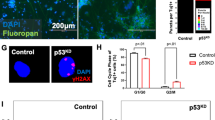Abstract
Neural progenitors show a strong tendency to undergo apoptosis in response to DNA damage, and both impaired DNA repair and increased neural progenitor apoptosis are associated with microcephaly. Here we present an immunohistochemistry-based method for assessing DNA damage and apoptosis in the neonatal mouse brain. These methods are suitable for determining in specific experimental conditions the fractions of cells with DNA double-strand breaks, the fractions of cells undergoing apoptosis, or both. While DNA damage in neural progenitors can trigger apoptosis, inappropriate apoptosis may also result from other processes. Simultaneous analysis of DNA damage and apoptosis in mouse models of microcephaly can determine how genetic instability and cell death contribute to the observed phenotype.
Access this chapter
Tax calculation will be finalised at checkout
Purchases are for personal use only
Similar content being viewed by others
References
Lee Y et al (2012) ATR maintains select progenitors during nervous system development. EMBO J 31:1177–1189
Frappart PO, McKinnon PJ (2008) Mouse models of DNA double-strand break repair and neurological disease. DNA Repair (Amst) 7:1051–1060
McKinnon PJ, Caldecott KW (2007) DNA strand break repair and human genetic disease. Annu Rev Genomics Hum Genet 8:37–55
Abner CW, McKinnon PJ (2004) The DNA double-strand break response in the nervous system. DNA Repair (Amst) 3:1141–1147
Veleta KA et al (2021) Antiapoptotic Bcl-2 family proteins BCL-xL and MCL-1 integrate neural progenitor survival and proliferation during postnatal cerebellar neurogenesis. Cell Death Differ 28:1579–1592
Arbour N et al (2008) Mcl-1 is a key regulator of apoptosis during CNS development and after DNA damage. J Neurosci 28:6068–6078
Crowther AJ et al (2016) Radiation sensitivity in a preclinical mouse model of Medulloblastoma relies on the function of the intrinsic apoptotic pathway. Cancer Res 76:3211–3223
Garcia I et al (2013) Bax deficiency prolongs cerebellar neurogenesis, accelerates medulloblastoma formation and paradoxically increases both malignancy and differentiation. Oncogene 32:2304–2314
Podhorecka M, Skladanowski A, Bozko P (2010) H2AX phosphorylation: its role in DNA damage response and cancer therapy. J Nucleic Acids 2010:920161
Nicholson DW et al (1995) Identification and inhibition of the ICE/CED-3 protease necessary for mammalian apoptosis. Nature 376:37–43
Fernandes-Alnemri T, Litwack G, Alnemri ES (1994) CPP32, a novel human apoptotic protein with homology to Caenorhabditis elegans cell death protein Ced-3 and mammalian interleukin-1 beta-converting enzyme. J Biol Chem 269:30761–30764
Author information
Authors and Affiliations
Corresponding author
Editor information
Editors and Affiliations
Rights and permissions
Copyright information
© 2023 Springer Science+Business Media, LLC, part of Springer Nature
About this protocol
Cite this protocol
De la Cruz, G., Nikolaishvili-Feinberg, N., Gershon, T.R. (2023). Automated Immunofluorescence Staining for Analysis of DNA Damage and Apoptosis in Brain Sections. In: Gershon, T. (eds) Microcephaly. Methods in Molecular Biology, vol 2583. Humana, New York, NY. https://doi.org/10.1007/978-1-0716-2752-5_6
Download citation
DOI: https://doi.org/10.1007/978-1-0716-2752-5_6
Published:
Publisher Name: Humana, New York, NY
Print ISBN: 978-1-0716-2751-8
Online ISBN: 978-1-0716-2752-5
eBook Packages: Springer Protocols




